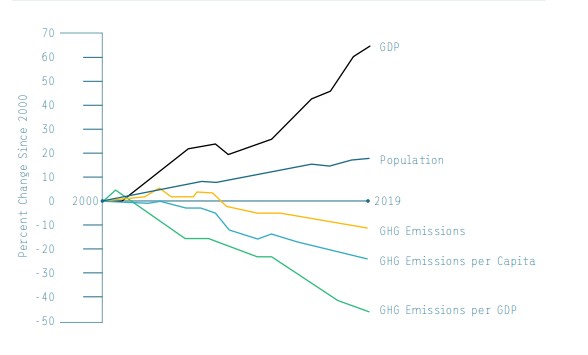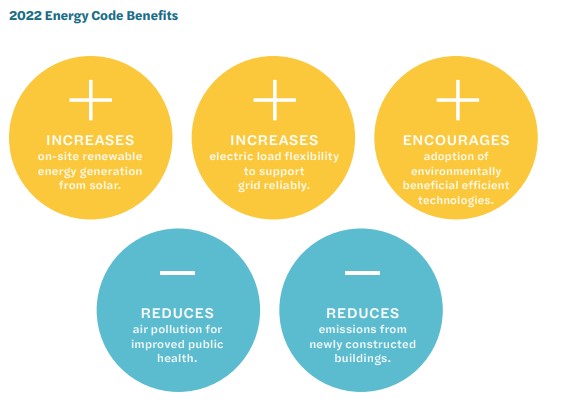Every three years, the California Energy Commission (CEC) updates its section of the Building Standards Code, Title 24 Part 6 – California Energy Code, by working with stakeholders in a public and transparent process. The updated 2022 Code took effect on January 1, 2023. The goal is to improve efficiency and reduce emissions from California homes and businesses, which represent 70 percent of the state’s electricity use and are responsible for a quarter of the state’s greenhouse gas emissions.
Nationally, California is a leader in environmental standards, and Title 24 is one of the tools state leaders use to push the envelope. The Title 24 Building Standards Code dates back to 1978, when previously disjointed building regulations were unified, covering all aspects of building construction. As climate change and greenhouse gas emissions have become pressing issues, energy use and emissions standards have become more critical.
As we adopt the 2022 code, there are several changes school districts, architects, and engineers need to understand better. We talked with Michael Adams, CEA, LEED AP BD+C, to get answers and some perspective. Michael is an associate and senior energy analyst at Glumac; a global engineering firm focused on creating sustainable, resilient buildings that provide healthy, productive, and equitable spaces for all communities. Glumac is an engineering partner on many HMC projects.
What are the noteworthy changes to the Title 24 energy code?
One of the significant changes is a prescriptive requirement for solar photovoltaic and battery storage systems for most non-residential new construction building types (Section 140.10). The amounts are based on a project’s conditioned square footage or available roof area (calculated as Solar Access Roof Area – SARA). Although a prescriptive requirement only, it will make it difficult for applicable buildings to meet Title 24 compliance via the performance approach without any renewable/battery storage systems in their design.
For non-residential projects, there are various improvements to performance requirements for the envelope, mechanical, lighting, and plumbing systems. A few of the more notable changes include:
- Increased prescriptive insulation requirements on metal-framed exterior walls
- High prescriptive glazing performance (U-Value and SHGC) with new climatezone-specific requirements
- Reduced prescriptive lighting power density (LPD) requirements
- Increased mandatory mechanical system efficiencies
- Increased prescriptive requirements on airside economizers on smaller systems (some exceptions)
- Prescriptive mechanical system type requirements (heat-pump based) for some program and building types
- High mandatory insulation performance requirements for envelope systems in alteration/addition projects

What are the impacts and cost implications of the updated energy regulations?
The photovoltaic/battery and higher performance standards requirements will increase first costs (the initial cost to construct). We expect that there will be lower energy use intensity (EUI), lower greenhouse gas emissions, and lower utility bills throughout the life of the building.
Additionally, these code changes will push more projects to consider energy use holistically, modeling actual predicted energy use rather than checking the boxes on a list of different components that must meet minimum requirements. This will require an increased understanding and knowledge of the Title 24 Part 6 energy code.
Can we assume the increased first costs will offset lifecycle cost savings?
Some studies attempt to quantify this —proposed adjustments to the energy code require a cost-effectiveness study (WarrenAlquist Act) and various justifications on other Reach and CASE studies. Historically, the triannual code cycle has improved prescriptive building performance by approximately five to 15 percent beyond the previous code cycle through the past five code cycles. In general, no blanket percentage or rough order of magnitude (ROM) values can be provided at this time for the widespread impact of this code cycle.
It’s easy to get lost in the potential sticker shock of these changes. What positive impacts can we expect to see as a result?
These are necessary steps in addressing climate change and setting a national and global precedent that it can be done. The graph above illustrates emissions (in CA) against Gross Domestic Product (GDP), a measure of economic activity, and population during the past 20-year time span. While the GDP and population continue to grow, the GHG emissions in California continue to decline in total and per capita and GDP; history shows us that the California Energy Code advancements are making a difference.
As climate change and greenhouse gas emissions have become pressing issues, energy use and emissions standards have become more critical.
The more extreme weather conditions experienced around the world are a direct result of the additional greenhouse gases (GHGs) in the atmosphere – the largest of these gases is carbon. The building industry is responsible for about 40 percent of GHGs. Therefore, energy use reduction and renewable energy offsets are vital to reducing GHGs and lowering the carbon levels in the atmosphere. I would add: It’s essential to remember that these changes are for the long-term greater good of humans. The planet will survive and even thrive without us. We must design for the future and not ignore the long-term consequences our designs can have.

Finally, I asked Michael to step back from his more technical analysis and talk about the additional complexity in the code and what the sense is among his colleagues. He explained, “One thing that is becoming more and more clear to the CEC is there is a lot of complexity and difficulty in navigating the energy code for all stakeholders—AHJ personnel (Authority Having Jurisdiction), designers, builders, and contractors.
Although the 2022 code cycle is solidified and finalized, for the 2025 code cycle, the CEC has identified ‘complexity of documents’ as a key issue to be addressed. There will be a high priority on simplifying and streamlining documents to ultimately improve energy code compliance.” From the perspective of architects, engineers, and school facilities professionals this is welcome news.

